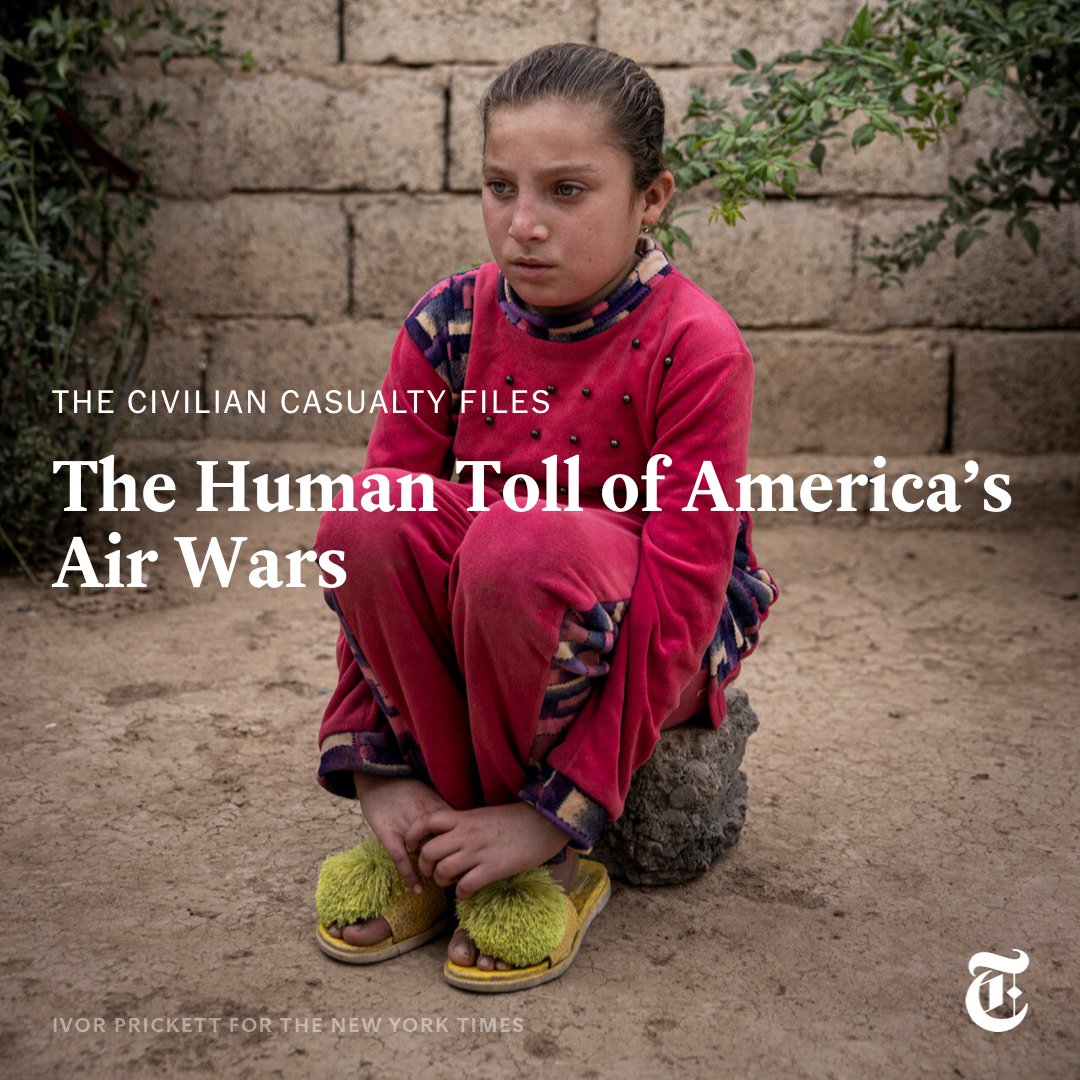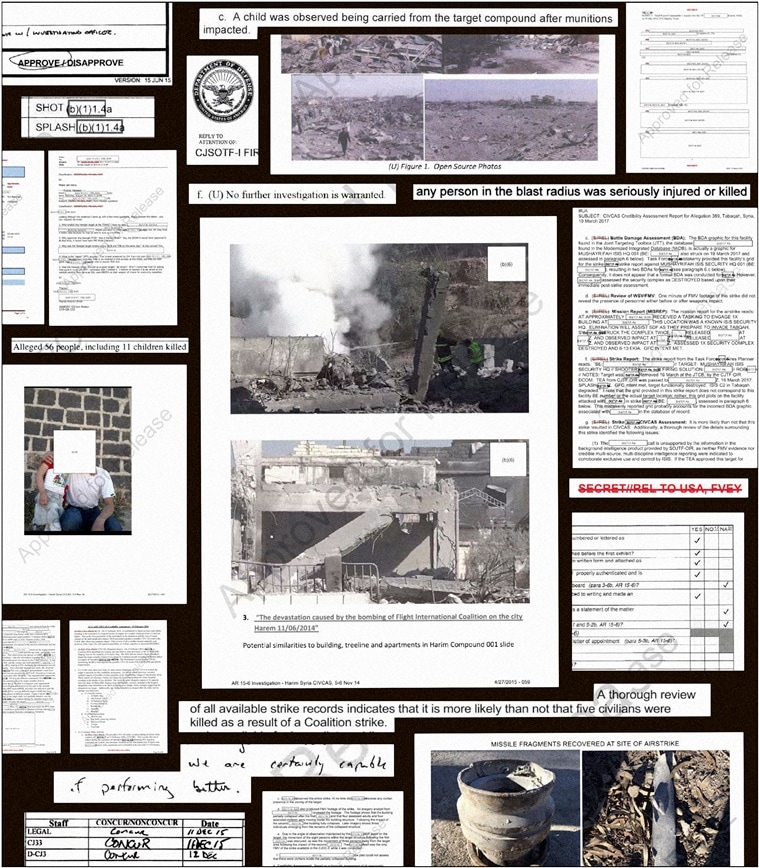
The Pentagon’s Secret Civilian Casualty Files
Azmat Khan, Lila Hassan, Sarah Almukhar and Rachel Shorey / The New York Times
(December 18, 2021) — The New York Times is making public hundreds of the Pentagon’s confidential assessments of reports of civilian casualties resulting from US-led airstrikes in Iraq and Syria. The documents lay bare how the air war has been marked by deeply flawed intelligence, rushed and often imprecise targeting, and the deaths of thousands of innocent civilians, many of them children.
The documents were obtained through Freedom of Information requests beginning in March 2017 and subsequent lawsuits filed against the Defense Department and the US Central Command. To date, The Times has received more than 1,300 reports examining airstrikes in Iraq and Syria from September 2014 to January 2018, more than 5,400 pages in all.
Independent reporting by The Times has closely matched much of the basic information from the documents, but it also found important discrepancies and oversights in some instances, including the location of a strike or the number of people killed or injured. Despite the inaccuracies, the documents serve as an important record for researchers seeking to understand the Pentagon’s internal processes…. [Read more online.]
Hidden Pentagon Records Reveal
Patterns of Failure in Deadly Airstrikes

Azmat Khan / The New York Times
This is the first part of a series. Part 2 will examine the air war’s human toll.
(December 18, 2021) — The promise was a war waged by all-seeing drones and precision bombs. The documents show flawed intelligence, faulty targeting, years of civilian deaths — and scant accountability.
Shortly before 3 a.m. on July 19, 2016, American Special Operations forces bombed what they believed were three ISIS “staging areas” on the outskirts of Tokhar, a riverside hamlet in northern Syria. They reported 85 fighters killed. In fact, they hit houses far from the front line, where farmers, their families and other local people sought nighttime sanctuary from bombing and gunfire. More than 120 villagers were killed.
In early 2017 in Iraq, an American war plane struck a dark-colored vehicle, believed to be a car bomb, stopped at an intersection in the Wadi Hajar neighborhood of West Mosul. Actually, the car had been bearing not a bomb but a man named Majid Mahmoud Ahmed, his wife and their two children, who were fleeing the fighting nearby. They and three other civilians were killed.
In November 2015, after observing a man dragging an “unknown heavy object” into an ISIS “defensive fighting position,” American forces struck a building in Ramadi, Iraq. A military review found that the object was actually “a person of small stature” — a child — who died in the strike.
None of these deadly failures resulted in a finding of wrongdoing.
These cases are drawn from a hidden Pentagon archive of the American air war in the Middle East since 2014.
The trove of documents — the military’s own confidential assessments of more than 1,300 reports of civilian casualties, obtained by The New York Times — lays bare how the air war has been marked by deeply flawed intelligence, rushed and often imprecise targeting and the deaths of thousands of civilians, many of them children, a sharp contrast to the American government’s image of war waged by all-seeing drones and precision bombs.
The documents show, too, that despite the Pentagon’s highly codified system for examining civilian casualties, pledges of transparency and accountability have given way to opacity and impunity. In only a handful of cases were the assessments made public. Not a single record provided includes a finding of wrongdoing or disciplinary action. Fewer than a dozen condolence payments were made, even though many survivors were left with disabilities requiring expensive medical care. Documented efforts to identify root causes or lessons learned are rare.
The air campaign represents a fundamental transformation of warfare that took shape in the final years of the Obama administration, amid the deepening unpopularity of the forever wars that had claimed more than 6,000 American service members. The United States traded many of its boots on the ground for an arsenal of aircraft directed by controllers sitting at computers, often thousands of miles away. President Barack Obama called it “the most precise air campaign in history.”

Abdulrahman Saad was killed in a 2017 US airstrike in Iraq.
This was the promise: America’s “extraordinary technology” would allow the military to kill the right people while taking the greatest possible care not to harm the wrong ones.
The ISIS caliphate ultimately crumbled under the weight of American bombing. For years, American air power was crucial to the beleaguered Afghan government’s survival. And as US combat deaths dwindled, the faraway wars, and their civilian tolls, receded from most Americans’ sights and minds.
On occasion, stunning revelations have pierced the silence. A Times investigation found that a Kabul drone strike in August, which American officials said had destroyed a vehicle laden with bombs, had instead killed 10 members of one Afghan family. The Times recently reported that dozens of civilians had been killed in a 2019 bombing in Syria that the military had hidden from public view. That strike was ordered by a top-secret strike cell called Talon Anvil that, according to people who worked with it, frequently sidestepped procedures meant to protect civilians. Talon Anvil executed a significant portion of the air war against ISIS in Syria.
The Pentagon regularly publishes bare-bones summaries of civilian casualty incidents, and it recently ordered a new, high-level investigation of the 2019 Syria airstrike. But in the rare cases where failings are publicly acknowledged, they tend to be characterized as unfortunate, unavoidable and uncommon.
In response to questions from The Times, Capt. Bill Urban, the spokesman for the US Central Command, said that “even with the best technology in the world, mistakes do happen, whether based on incomplete information or misinterpretation of the information available. And we try to learn from those mistakes.” He added: “We work diligently to avoid such harm. We investigate each credible instance. And we regret each loss of innocent life.”

Read the military’s full responses to questions from The Times.
He described minimizing the risk of harm to civilians as “a strategic necessity as well as a legal and moral imperative,” driven by the way these casualties are used “to feed the ideological hatred espoused by our enemies in the post 9/11 conflicts and supercharge the recruiting of the next generation of violent extremists.”
Yet what the hidden documents show is that civilians have become the regular collateral casualties of a way of war gone badly wrong.
To understand how this happened, The Times did what military officials admit they have not done: analyzed the casualty assessments in aggregate to discern patterns of failed intelligence, decision-making and execution. It also visited more than 100 casualty sites and interviewed scores of surviving residents and current and former American officials. In the coming days, the second part of this series will trace those journeys through the war zones of Iraq and Syria.
Taken together, the reporting offers the most sweeping, and also the most granular, portrait of how the air war was prosecuted and investigated — and of its civilian toll.
There is no way to determine that full toll, but one thing is certain: It is far higher than the Pentagon has acknowledged. According to the military’s count, 1,417 civilians have died in airstrikes in the campaign against ISIS in Iraq and Syria; since 2018 in Afghanistan, US air operations have killed at least 188 civilians. But The Times’s analysis of the documents found that many allegations of civilian casualties had been summarily discounted, with scant evaluation. And the on-the-ground reporting — involving a sampling of cases dismissed, cases deemed “credible” and, in Afghanistan, cases not included in the trove of Pentagon documents — found hundreds of deaths uncounted.
The war of precision did not promise that civilians would not die. But before a strike is approved, the military must undertake elaborate protocols to estimate and avoid civilian harm; any expected civilian casualties must be proportional to the military advantage gained. And America’s precision bombs are indeed precise: They hit their targets with near-unerring accuracy.
The documents, along with The Times’s ground reporting, illustrate the many, often disastrous ways the military’s predictions of the peril to civilians turn out to be wrong. Their lessons rarely learned, these breakdowns of intelligence and surveillance occur again and again. …. [Read more online.]

RELATED COVERAGE:
What to Know About the Airstrikes Investigation
Read the Trove of Pentagon Documents
Hidden Pentagon Records Reveal Patterns of Failure in Deadly Airstrikes
What to Know About the Civilian Casualty Files
Posted in accordance with Title 17, Section 107, US Code, for noncommercial, educational purposes.